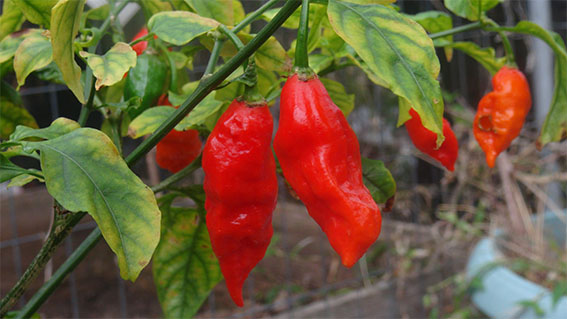By Helen
The Carolina Reaper was stated to be the hottest chili in the world according to the 2017 Guinness Book of Records. Trust me, I would know how devastatingly hot they are because I grew them last summer and I got myself into a little pickle, which I’ll tell you about later. Being a keen home gardener, I enjoy growing my own produce. It’s especially rewarding when you grow plants in the garden that give you a great harvest without too much effort. I enjoy growing peppers because they look stunning with their striking colours and they also give you an abundance of fruit without needing to grow too many plants. I had already grown Bird’s Eye chili and other milder varieties, but I had never tried to grow any extremely hot chili varieties. Seeing Carolina Reaper’s pictures on the internet inspired me to grow them for myself.
One of the benefits of living in a warm climate, like here in Queensland, Australia is that you can grow a variety of chili peppers all year round and they are easy enough to look after because they don’t usually get attacked by insects. Other produce can get a little finicky – like tomatoes and cucumbers, especially in the highest heat temperature of summertime, and especially when the summer rains hit. The high humidity attracts bugs that love to come out and feed on your crops for one thing. Consistent watering is another issue.
The Carolina Reaper varieties were relatively easy for me to grow at home. I grew both the standard Red and the Chocolate Carolina Reaper. If you are looking to grow them yourself, just make sure that the weather is warm when sowing seed – the temperature of the soil should reach a heat range of 22-35 degrees Celsius, as it does here in Queensland toward the end of spring. They love warm soil, so if they are not sprouting between 7-21 days from sowing, it is probably because your soil isn’t hot enough. Mine sprouted within approximately ten days. If you want to start them sooner, you could grow them under lamps or in a greenhouse.
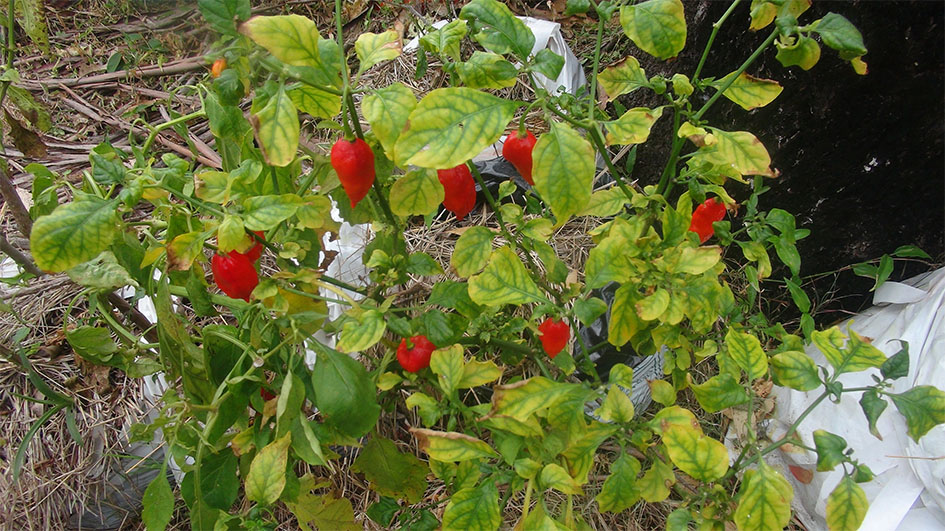
The Red Carolina Reaper plant
I like to use recycled materials when I garden, so I use these plastic Kiwi fruit packets from the supermarket because of their built-in lid. They function like a mini greenhouse and help to stop the soil from drying out. I plant the seeds about 1 cm deep into the soil and then cover them. You should consistently check to make sure the soil hasn’t dried out and is always damp to the touch. Sometimes I use Coco Peat to sprout my seeds, but usually, a standard potting mix will do the job anyway. After they are about 3-4 cm in height, I replant them in bigger pots. I try to take care not to move the root system too much because I have found that all pepper plants, including capsicums and hot chilies, don’t take to replanting too well. They take a little while to recover, (sometimes if at all from transplant shock) especially the bigger they are.
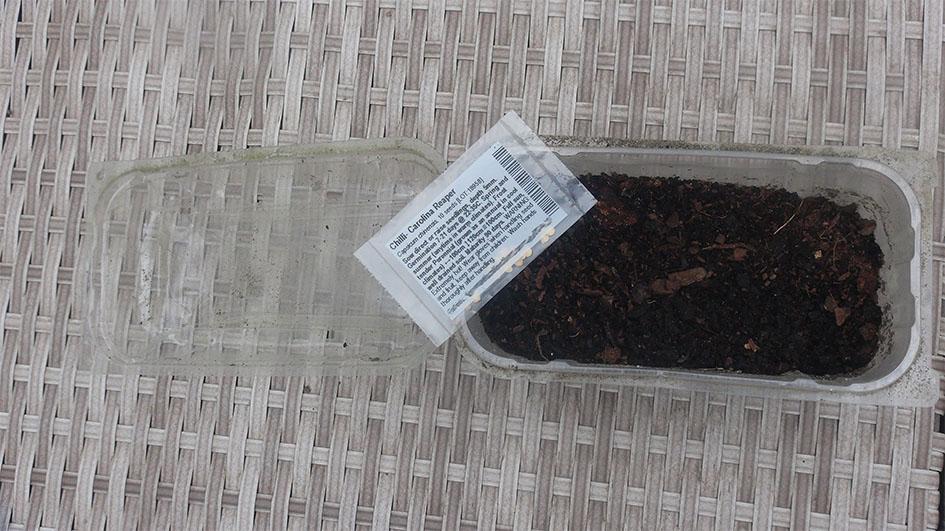
The Kiwi fruit containers function like small greenhouses
When replanting into bigger pots or bags, I added 20% manure to the potting mix to keep the plant growing healthily. Then I added grass as mulch to keep the soil moist. You could also fertilize the plant every week with manure tea. Chili plants don’t like too much water, as the root system can rot and eventually kill the plant. I pop my finger in the soil and check that the soil is damp, but not too wet to check water levels. Honestly, I haven’t always gotten this one right because I have had a few develop a fungal disease and eventually die because of overwatering. I think it’s all about trial and error, the more you garden with chili plants, the better you will get at caring for them.
Chilis can grow all year round in warm climates. They can also be grown as an annual in cool climates but really, they should be kept in a warm place like a greenhouse or indoors to ensure they will reach maturity (it takes 90 days). In warm climates, the plant should live through the winter and also keep on producing fruit. They will usually show signs of dying down or yellowing leaves as in my case. My reaper plants seemed to be the most resilient out of my other chili plants, continuing to fruit even through the wintertime.
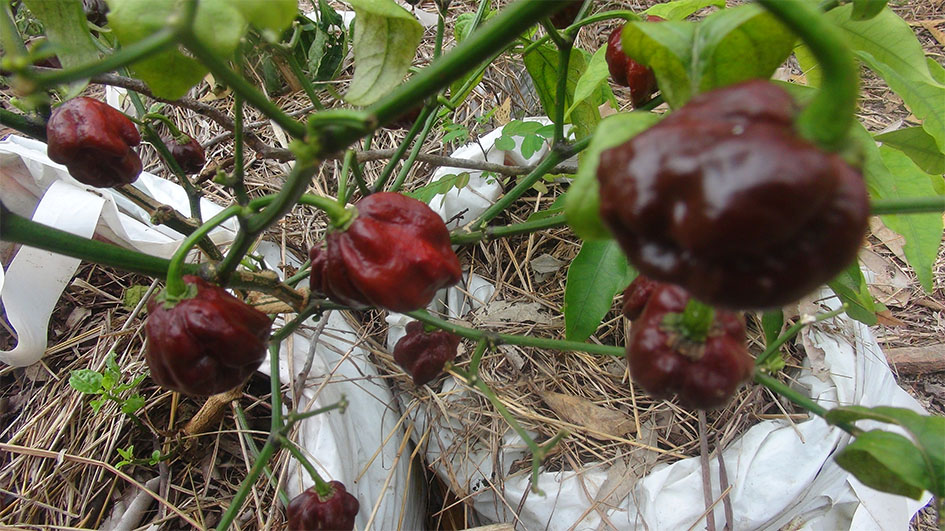
The Chocolate Carolina Reaper plant
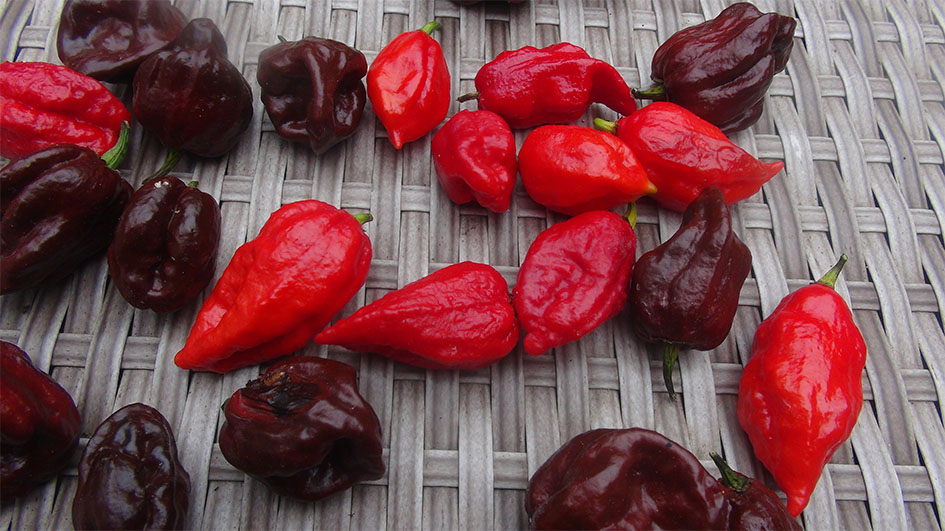
The Red and Chocolate Carolina Reaper (I have so many of them!)
More about the chili ‘beast’
The Carolina Reaper is actually a cultivar that was created by Ed Currie from California. He is the proprietor of the Puckerbutt Pepper Company in Fort Mill. The chili variety was initially created by crossbreeding two very hot chilis: the La Soufriere pepper from Saint Vincent and the Naga pepper from Pakistan. Apparently, after 2017, the reaper was no longer rated the hottest chili in the world. New breeds such as Dragon’s Breath pepper and Pepper X have surpassed the reaper in SHU heat ratings.1
Whew, I can’t believe you can actually get a hotter chili than the Reaper, but there you go. It’s been done.
Capsaicin is what gives chili its heat levels. Hot Chili peppers are rated by the amount of heat present using Scoville Heat Units. It’s a way of measuring how hot different chili varieties are by the amount of capsaicin compound levels present. The scale ranges between 0-12 ratings.
At the highest range of 12 are listed the hottest chilis available which include Ghost Peppers, Naga Viper, 7 Pot Primo, 7 Pot Douglah, Trinidad Moruga Scorpion, and of course the Carolina Reaper. The SHU rating for chilies within the 12th range is between 855,000 thousand to 2,200,000 million. The reaper hit 1.641 million SHU. 2 A few of the chilis in this range are considered to be ‘not for human consumption’. I have to agree.
After growing these little beasts, I decided not to use them for cooking or keeping them in the kitchen at all. I learned the hard way – you have to be very careful when handling them and make sure you wear gloves! Little did I know I would be paying the price when I cut a few of these without gloves to keep the seeds.
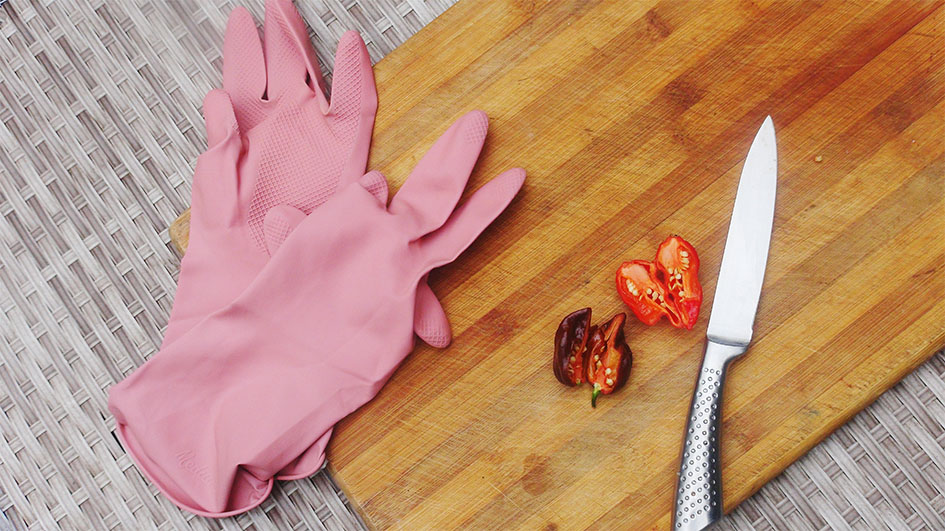
Don’t forget to wear gloves if you are saving seed!!
Did I try eating them?
No, I decided not to. After seeing ‘cool’ macho guys on YouTube trying to prove how brave they were by chewing and swallowing, only to find their egos sorely bruised, I knew these chilies were seriously deadly. Apparently, a 34-year-old guy had to go to the ER after he had severe and striking head pains for days after eating a reaper. 3
Never play with fire!
I decided to handle a few of them so I could save seed but without gloves. The oils from the chili went into my fingernails, under the skin and both hands were in pretty bad shape for a good eight hours. My fingertips felt exactly like they had been burned on a stovetop, but it didn’t happen straight away. It began to burn about an hour after handling them and it got progressively worse for the next 2 hours as it went deeper into the skin. I had to get a bowl filled with ice blocks and stick my fingers in them for the next few hours and I also had to carry an ice pack with me to bed. Boy, that was not a fun experience! I tried to use milk and ice-blocks and that seemed to work better than plain water. This worked much better than trying to remove the oils with vinegar spray. It just made it hurt more.
If this happens to you, and you accidentally handle the chilies without gloves, just remember this. THE PAIN WILL PASS. I promise you. It passed for me completely after about eight hours. Hang in there and whatever you do, don’t panic.
So, growing the Carolina Reaper is not really hard. From my experience, I think any home gardener who lives in a warm climate can grow them successfully. If you are keen to grow this hot beast in your garden, just remember to stay safe and never play with fire!
Have you found yourself in a pickle with a hot chili burn? What did you use/do to handle the pain? Write your comments below!
References:
- Carolina Reaper – Wikipedia
- Hot Chile Peppers on the Scoville Scale (thespruceeats.com)
- Man Goes to Emergency Room, Tested for Brain Damage After Eating World’s Hottest Chili Pepper (newsweek.com)

